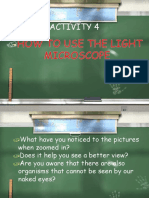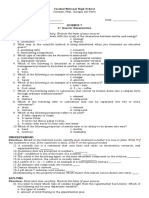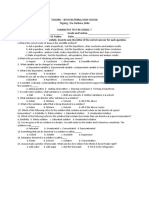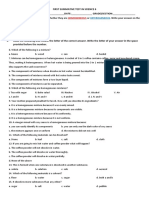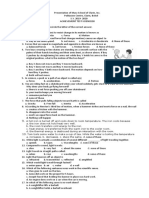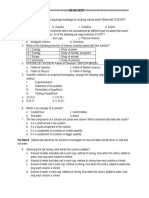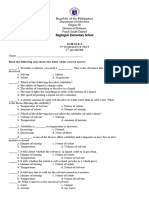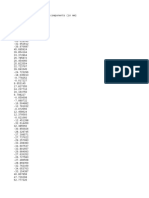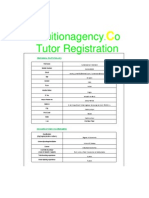100%(1)100% found this document useful (1 vote)
262 views1st Periodic Test in Science
1st Periodic Test in Science
Uploaded by
criselThis document appears to be a science exam for 7th grade students covering topics related to solutions and the scientific method. It contains multiple choice, true/false, fill-in-the-blank, and matching questions testing students' understanding of key terms like solvent, solute, saturated, unsaturated, concentrated solutions, and steps of the scientific method. The exam also inquires about factors that affect solubility and various separation techniques such as distillation and evaporation.
Copyright:
© All Rights Reserved
Available Formats
Download as DOCX, PDF, TXT or read online from Scribd
1st Periodic Test in Science
1st Periodic Test in Science
Uploaded by
crisel100%(1)100% found this document useful (1 vote)
262 views2 pagesThis document appears to be a science exam for 7th grade students covering topics related to solutions and the scientific method. It contains multiple choice, true/false, fill-in-the-blank, and matching questions testing students' understanding of key terms like solvent, solute, saturated, unsaturated, concentrated solutions, and steps of the scientific method. The exam also inquires about factors that affect solubility and various separation techniques such as distillation and evaporation.
Original Description:
test
Copyright
© © All Rights Reserved
Available Formats
DOCX, PDF, TXT or read online from Scribd
Share this document
Did you find this document useful?
Is this content inappropriate?
This document appears to be a science exam for 7th grade students covering topics related to solutions and the scientific method. It contains multiple choice, true/false, fill-in-the-blank, and matching questions testing students' understanding of key terms like solvent, solute, saturated, unsaturated, concentrated solutions, and steps of the scientific method. The exam also inquires about factors that affect solubility and various separation techniques such as distillation and evaporation.
Copyright:
© All Rights Reserved
Available Formats
Download as DOCX, PDF, TXT or read online from Scribd
Download as docx, pdf, or txt
100%(1)100% found this document useful (1 vote)
262 views2 pages1st Periodic Test in Science
1st Periodic Test in Science
Uploaded by
criselThis document appears to be a science exam for 7th grade students covering topics related to solutions and the scientific method. It contains multiple choice, true/false, fill-in-the-blank, and matching questions testing students' understanding of key terms like solvent, solute, saturated, unsaturated, concentrated solutions, and steps of the scientific method. The exam also inquires about factors that affect solubility and various separation techniques such as distillation and evaporation.
Copyright:
© All Rights Reserved
Available Formats
Download as DOCX, PDF, TXT or read online from Scribd
Download as docx, pdf, or txt
You are on page 1of 2
Department of Education
Region IV-A (CALABARZON)
Division of Batangas
District of Balayan West
SAN PIRO NATIONAL HIGH SCHOOL
San Piro, Balayan, Batangas
FIRST QUARTER EXAMINATION IN SCIENCE 7
Name: ________________________Grade and Section: __________________Date: _____________Score: ______
I. Choose the letter of the correct answer.
1. Cardo wanted to test if sugar or salt dissolved faster in hot water. In order to do this, they followed certain steps to
complete the experiment. What part of the scientific method is this called?
A. data B. procedure C. purpose D. results
2. You wanted to do an experiment with magnets. In order to do that you listed the things you needed to do the
experiment: magnets, toy cars, and rubber bands. What step of the scientific method is being described by the situation?
A. hypothesis B. materials C. procedure D. data
3. Sir Jade was testing to see which ball, a basketball or volleyball, would bounce higher. Before he did the experiment,
he guessed what he thought would happen before the experiment. What step of the scientific method is this?
A. purpose B. materials C. hypothesis D. data
4. Which of the following is NOT a factor that affects the solubility of matter?
A. container B. nature of solute C. particle size D. temperature
5. What factors affect solubility?
I. nature of solute II. container of solute III. temperature IV. texture
A. I and II B. I and III C. I and IV D. I, II and IV
6. The phrase “like dissolves like” refers to the fact that ________________.
A. Polar solvents dissolve non polar solvent solutes and vice versa
B. Solvents can dissolve solutes of similar molar mass
C. Gases can only dissolve other gases
D. Polar solvents dissolve polar solutes and non-polar solvents dissolve non-polar solutes.
7. Which of the following sugar solutions is the most concentrated?
A. 2 g of sugar in 100 mL of water C. 15 g of sugar in 25 mL of water
B. 12 g of sugar in 30 mL of water D. 5 g of sugar in 60 mL of water
8. Which process/processes affect the speed of dissolving?
A. stirring only C. particle size only
B. particle size, temperature, stirring D. type of the container used
Use the picture of a certain solution below to answer questions
9. Which test tube shows diluted solution? ______ A. B. C. D. E.
10. Which test tube shows concentrated solution?_____
11. Which of the following describes a diluted solution?
A. it has a small amount of dissolved solute in a much less amount of solute
B. It has the same amount of dissolved solute and solvent.
C. It has a small amount of dissolved solute in comparison to the given amount of solvent.
D. It has a greater amount of dissolved solute in a given amount of solvent. 12. When there is a large amount of
dissolved solute for a certain volume of solvent, the solution is said to be ________________-.
A. diluted B. unsaturated C. concentrated D. heterogeneous
13. . Which factor would not affect the rate solubility of sugar in water?
A. Heat the water and sugar C. Grind the sugar to make it finer.
B. Stir the water and sugar D. Add the sugar to the water.
14. When you put the coffee into the hot water you observed that it was easily dissolved. In this situation, what affects the
solubility of substance?
A. size B. temperature C. texture D. container
15. Which of the following will greatly affect the solubility of solid at room temperature?
A. thickness B. pressure C. particle size D. texture
16. What is the maximum amount of solute that can be dissolved in a fixed amount of solvent at a given temperature?
A. dilution B. dissolution C. percent by mass D. solubility
17. How many grams of glucose (C12 H22 O11) are needed to prepare 400ml of a 5% glucose solution?
A. 5g B. 10g C. 14g D. 20g
18. What is the percentage concentration in the following solution: 2g sucrose in 80 grams?
A. 97.6% B. 2.5% C. 4.4% D. 2.4%
19. Sterling silver contains 95% silver. If a necklace made of sterling silver weighs 15g, what is the mass of silver
dissolved in the necklace?
A. 14.25g B. 9.0g C. 6.2g D. 1.6
Department of Education
Region IV-A (CALABARZON)
Division of Batangas
District of Balayan West
SAN PIRO NATIONAL HIGH SCHOOL
San Piro, Balayan, Batangas
20. The two components of a solution are _______________.
A. homogeneous and heterogeneous C. concentrated and diluted
B. solvent and solute D. saturated and unsaturated
21. Which of the following pair of substance may be separated through distillation?
A. sand and soil B. water and salt C. salt and sand D. water and alcohol
22. Which one of the following is a disadvantage of distillation?
a. It always requires heat C. All of the solute is recovered
b. The solvent is not recovered D. It cannot be used for insoluble solid
23. The flow diagram shows how a pupil extracted pure, dry salt from rock salt.
Crushing Dissolving Filtration
Which of the following processes will complete the flow diagram?
A. Distillation B. Condensation C. Melting D. Freezing
24. Which of the following shows shows the separation technique of
distillation?
25. Which of the following shows shows the separation technique of
evaporation? A B. C. D.
II. Write TRUE if the statement is true and FALSE if it is false.
_____ 26. Ivan was testing which color candle would burn the fastest with their teacher. They thought the red one would
burn the fastest and made their prediction before doing the experiment. The situation refers in making hypothesis.
_____ 27. When the temperature is decreased the solid solute will dissolve faster.
_____ 28. Many solutions are made for a specific purpose.
_____ 29. Water is considered as the universal solute.
_____ 30. In a solution, the component present in small amount is solute.
_____ 31. One of the factors affecting the solubility of substances is the size of particles.
_____ 32. Rock salt dissolves faster than the crushed salt.
_____ 33. Mixture contains one element.
_____ 34. Gasoline is an example of solution.
_____ 35. All solutions are safe to use.
_____ 36. Seawater has a single element.
_____ 37. Polar solvents cannot dissolve non-polar solutes.
_____ 38. Everything that dissolves in water is a non-polar solute.
______ 39. In evaporation, the solvent is not recovered.
_____ 40. The temperature of a substance is fixed and sharp while the temperature of mixture is different at different
times.
III. Identify the word being described by the following statements. Fill in the blanks with the missing letters to
form the answer.
41. Christian was testing which balloon rocket would go the fastest. After they did each test, they recorded their findings
on a chart. These findings are what part of the scientific method? D____ T ____
42. A solution that contains the maximum amount of solute dissolved by a given amount of solvent. S_T_ _ A_ _D
43. A solution that contains less amount of solutes than the amount of it can dissolve at a given temperature. U_ _AT_R__ __ __D
44. A component present in a small amount in a solution. S_____ _____ UT_____
45. A component present in a greater amount present in a solution. ____ ____ L____ E_____ T
IV. Match each word in column A to its meaning in column B.
A. B.
A. A solution which has the greater amount of solute for a
____ 46. Evaporation certain volume of solvent
____ 47. Melting B. These are homogeneous mixtures that may be solid
____ 48. Concentrated dissolved in a liquid or gases dissolved in liquids
____ 49. Distillation C. Commonly used method for purifying liquids and
____ 50. Solutions separating mixtures of liquids into their individual
components.-distillation
D. The process of turning liquid in to gas.
E. A transition of substance from a solid to liquid
God Bless!!!
Prepared by: Checked by:
CHRISTIAN JADE D. ALAMAG MARIA LOURDES A. TENORIO
Teacher I Principal II
You might also like
- Chem M7 SolutionsDocument28 pagesChem M7 SolutionsAnne GimoteaNo ratings yet
- DLL-G7 First Quarter Lesson 1Document3 pagesDLL-G7 First Quarter Lesson 1crisel0% (1)
- Activity 4Document65 pagesActivity 4criselNo ratings yet
- Joel Wanted To Find Out How Much Salt Is Needed To Make Saturated Solution in 100 ML of WaterDocument5 pagesJoel Wanted To Find Out How Much Salt Is Needed To Make Saturated Solution in 100 ML of Watersheila mae tadoNo ratings yet
- Antique National School Long Test in Science 7: For Items 6-9Document3 pagesAntique National School Long Test in Science 7: For Items 6-9Christine Joy Millares GimenoNo ratings yet
- 1st PERIODICAL IN SCIENCE 7 2019 - 2020Document8 pages1st PERIODICAL IN SCIENCE 7 2019 - 2020Belinda LapsitNo ratings yet
- First Summative Test in Science 7Document5 pagesFirst Summative Test in Science 7Monica P. RamosNo ratings yet
- First Periodic Test in Science 6-DaveDocument7 pagesFirst Periodic Test in Science 6-DaveDave TenorioNo ratings yet
- First Quarter ExaminationDocument3 pagesFirst Quarter ExaminationLo ViNo ratings yet
- Department of Education: Republic of The PhilippinesDocument4 pagesDepartment of Education: Republic of The PhilippinesMae CudalNo ratings yet
- 1st-Periodical-Test-SCIENCE-6 WT Levels of UnderstandingDocument6 pages1st-Periodical-Test-SCIENCE-6 WT Levels of UnderstandingDanski Pomilar100% (3)
- 1st Periodic Test - Science 7Document4 pages1st Periodic Test - Science 7Joan Alfaras75% (4)
- Local Media4318719121422453373Document5 pagesLocal Media4318719121422453373Raquel De CastroNo ratings yet
- Science Quiz Q1Document1 pageScience Quiz Q1Mira Comendador BantilanNo ratings yet
- Science 7 1st Quarter ExamDocument2 pagesScience 7 1st Quarter ExamLeslie Quingco100% (3)
- Science 7 First Periodic Examination 2022 2023Document3 pagesScience 7 First Periodic Examination 2022 2023Sheena Acayan100% (1)
- Grade 7 MonthlyDocument3 pagesGrade 7 MonthlyGlenn ClementeNo ratings yet
- 1st Quarter Exam S.y.2018-2019Document19 pages1st Quarter Exam S.y.2018-2019Ruby Rose Reambonanza MagsolingNo ratings yet
- DIVTESTSCIG71STQUARTERDocument7 pagesDIVTESTSCIG71STQUARTERBoyeth RulidaNo ratings yet
- Second Periodical Test in ScienceDocument2 pagesSecond Periodical Test in ScienceLorraine lee100% (1)
- Summative Test Science 7Document1 pageSummative Test Science 7Montealegre NhetNo ratings yet
- Science Grade 7Document5 pagesScience Grade 7CATHERINE D. FURING100% (1)
- I. Identify The Following Mixtures Whether They Are or - Write Your Answer On The Space ProvidedDocument4 pagesI. Identify The Following Mixtures Whether They Are or - Write Your Answer On The Space ProvidedEmily De JesusNo ratings yet
- QUARTER 2 Third-summative-test-2nd-qrtr-M5M6-SCIENCE 7Document2 pagesQUARTER 2 Third-summative-test-2nd-qrtr-M5M6-SCIENCE 7TEOFILA NOLASCO100% (1)
- First Quarter Exam Science 7Document5 pagesFirst Quarter Exam Science 7Mr-Butay IntanoNo ratings yet
- Science 08 atDocument4 pagesScience 08 atJoel Opciar CuribNo ratings yet
- Tatabunan Integrated School Talalora Samar First Periodical Examination Science - Grade 7Document2 pagesTatabunan Integrated School Talalora Samar First Periodical Examination Science - Grade 7Tinay TinayNo ratings yet
- 4TH QuarterDocument6 pages4TH QuarterTEACHER MILLAN TVNo ratings yet
- 1ST Summative Science7Document4 pages1ST Summative Science7Mae Cudal100% (1)
- Third Quarterly Examination For Science 7Document3 pagesThird Quarterly Examination For Science 7Jon Mitchel Galang100% (1)
- First Periodical Examination For GRADE 7 SCIENCEDocument2 pagesFirst Periodical Examination For GRADE 7 SCIENCEMyrson MalayanNo ratings yet
- 1st Quarter Science 7Document6 pages1st Quarter Science 7Sabnahis Batongbuhay ExtensionNo ratings yet
- Science 7 1st Quarter TestDocument4 pagesScience 7 1st Quarter TestUriah BoholstNo ratings yet
- 2nd Quarter Science 7Document19 pages2nd Quarter Science 7April Joy Yares SiababaNo ratings yet
- 1st Periodic Test - Science 7Document4 pages1st Periodic Test - Science 7laarni malata100% (1)
- Las Science 7 Melc 2 q2 Week-2Document13 pagesLas Science 7 Melc 2 q2 Week-2Meryjoy Tero Navares - PonceNo ratings yet
- Science: Quarter 1 - Module 3: Mixtures Vs Pure SubstancesDocument25 pagesScience: Quarter 1 - Module 3: Mixtures Vs Pure SubstancesROSALIE MEJIA100% (1)
- Directions: Read Each Item Carefully. Encircle The Letter of The Correct Answer For Each QuestionDocument6 pagesDirections: Read Each Item Carefully. Encircle The Letter of The Correct Answer For Each Questionedwin dumopoyNo ratings yet
- Validation 2 Quarter 2 Science 7Document4 pagesValidation 2 Quarter 2 Science 7Dwayne GreyNo ratings yet
- 3rd Grading Exam - Science 7Document6 pages3rd Grading Exam - Science 7Diane Marr Nicolas DencioNo ratings yet
- Diagnostic Test (Grade 8)Document5 pagesDiagnostic Test (Grade 8)Avon Kaye GeneralaoNo ratings yet
- Grade 7 Science Unified Test 1 QuarterDocument6 pagesGrade 7 Science Unified Test 1 QuarterMichael Deliva100% (2)
- Second Periodical Test - For ReDocument4 pagesSecond Periodical Test - For ReJessica Manawes Navor100% (1)
- Science 7 - Summative Test 1st QuarterDocument4 pagesScience 7 - Summative Test 1st QuarterEsther Mae Ann Trugillo50% (2)
- 4A and 4B Science7Document29 pages4A and 4B Science7Jonnah Faye MojaresNo ratings yet
- First Periodical Test in ScienceDocument6 pagesFirst Periodical Test in ScienceGrace GaraldeNo ratings yet
- g7 Science 1st Quarter (w1)Document3 pagesg7 Science 1st Quarter (w1)Heena LeguipNo ratings yet
- Second Quarter Periodic Test 2022 2023Document6 pagesSecond Quarter Periodic Test 2022 2023Rusthel Joyce MataNo ratings yet
- Science 6Document6 pagesScience 6Iries ItoNo ratings yet
- Science 7 First QuarterDocument5 pagesScience 7 First QuarterWillyn Grace Sacasac PacanosNo ratings yet
- DAILY LESSON LOG Week 3 Science 7Document3 pagesDAILY LESSON LOG Week 3 Science 7Matet GenerosaNo ratings yet
- Science 3 RD Periodical 2 K 19Document12 pagesScience 3 RD Periodical 2 K 19Jack RobertNo ratings yet
- Quarter 1-Week 1-Module 1-Steps in Scientific MethodDocument11 pagesQuarter 1-Week 1-Module 1-Steps in Scientific MethodJoe marie BotioNo ratings yet
- Science 7: First Quarter ExaminationDocument2 pagesScience 7: First Quarter Examinationmacren septemberNo ratings yet
- First Summative Test in Science 7Document3 pagesFirst Summative Test in Science 7Marianne Serrano100% (1)
- Grade 7 Final AssessmentDocument5 pagesGrade 7 Final AssessmentMary Joy TibayNo ratings yet
- 1ST Quarterly Exam in Science 6Document7 pages1ST Quarterly Exam in Science 6Rodel Ortega100% (1)
- Science 7Document4 pagesScience 7James Lacuesta Tabiolo25% (4)
- Science 7 First Quarter ExamDocument4 pagesScience 7 First Quarter Examgleen barrientosNo ratings yet
- 1st Unit Test Science 7Document5 pages1st Unit Test Science 7Sophia Acer ArtatesNo ratings yet
- 1st Periodical Test Science6 - SY.24 25Document5 pages1st Periodical Test Science6 - SY.24 25MilainNo ratings yet
- SCI6 - ST2 - Q1 W TOSDocument3 pagesSCI6 - ST2 - Q1 W TOSNovelyn MoralesNo ratings yet
- Consider Your Room's Position. Ask The Students On What Can Be Found On The: 1. North 2. East 3. South 4. WestDocument4 pagesConsider Your Room's Position. Ask The Students On What Can Be Found On The: 1. North 2. East 3. South 4. WestcriselNo ratings yet
- "When You Are Surrounded by People Who Share A PASSIONATE Commitment Around A Common PURPOSE, Anything Is POSSIBLE. " Howard SchultzDocument1 page"When You Are Surrounded by People Who Share A PASSIONATE Commitment Around A Common PURPOSE, Anything Is POSSIBLE. " Howard SchultzcriselNo ratings yet
- Air Is HeatedDocument21 pagesAir Is Heatedcrisel67% (3)
- What Are The Adequate Pedagogical Approaches For Teaching Scientific Disciplines? Physics As A Case StudyDocument8 pagesWhat Are The Adequate Pedagogical Approaches For Teaching Scientific Disciplines? Physics As A Case StudycriselNo ratings yet
- Activity: "Comparing Plant and Animal Cells"Document39 pagesActivity: "Comparing Plant and Animal Cells"criselNo ratings yet
- Conceptual FrameworkDocument1 pageConceptual FrameworkcriselNo ratings yet
- 2.parts of A PlantDocument20 pages2.parts of A PlantcriselNo ratings yet
- Transect No. 1: Mangrove and Molluscan Fauna Data SheetDocument5 pagesTransect No. 1: Mangrove and Molluscan Fauna Data SheetcriselNo ratings yet
- Causes of Seasons in The PhilippinesDocument23 pagesCauses of Seasons in The PhilippinescriselNo ratings yet
- Lesson On Biotic and Abiotic FactorsDocument21 pagesLesson On Biotic and Abiotic FactorscriselNo ratings yet
- Lesson On Biotic and Abiotic FactorsDocument21 pagesLesson On Biotic and Abiotic FactorscriselNo ratings yet
- Pure Substances, Mixtures, and SolutionsDocument19 pagesPure Substances, Mixtures, and SolutionscriselNo ratings yet
- Career Orientation For Grade 10 Students: Guiding Towards A Well-Informed ChoiceDocument2 pagesCareer Orientation For Grade 10 Students: Guiding Towards A Well-Informed ChoicecriselNo ratings yet
- The Effects of Single-Parent Households On The Literacy Achievement of Third-Grade African-American StudentsDocument19 pagesThe Effects of Single-Parent Households On The Literacy Achievement of Third-Grade African-American StudentscriselNo ratings yet
- Advancing Education in The Caribbean and Africa-2Document14 pagesAdvancing Education in The Caribbean and Africa-2criselNo ratings yet
- ENERGY ResourcesDocument19 pagesENERGY ResourcescriselNo ratings yet
- Distance and DisplacementDocument14 pagesDistance and DisplacementcriselNo ratings yet
- Asexual Vs Sexual ReproductionDocument53 pagesAsexual Vs Sexual ReproductioncriselNo ratings yet
- DLL G7 Lesson 1 Levels of OrganizationDocument3 pagesDLL G7 Lesson 1 Levels of Organizationcrisel100% (4)
- 2007 - Shellac in PolymerDocument43 pages2007 - Shellac in PolymerAnonymous x7VY8VF7No ratings yet
- Unit 039 Further Maths A2 2018-2019CDocument12 pagesUnit 039 Further Maths A2 2018-2019CtanNo ratings yet
- Series Solutions: Bessel Functions, Legendre Polynomials: WWW Problems and SolutionsDocument6 pagesSeries Solutions: Bessel Functions, Legendre Polynomials: WWW Problems and SolutionsAtoy ValdezNo ratings yet
- Curriculum Vitae: "Quality Control"Document5 pagesCurriculum Vitae: "Quality Control"jesishaliniNo ratings yet
- Linear Algebra For Test and Analysis: Imac - XixDocument74 pagesLinear Algebra For Test and Analysis: Imac - XixVitor PereiraNo ratings yet
- MIT18 06S10 Final Exam PDFDocument10 pagesMIT18 06S10 Final Exam PDFMRNo ratings yet
- Modern Structural AnalysisDocument26 pagesModern Structural Analysiswalter_m_cdr50% (4)
- Triton x-305 PDFDocument2 pagesTriton x-305 PDFAnonymous C3BD7OdNo ratings yet
- Prediction of Local Snow Loads On RoofsDocument130 pagesPrediction of Local Snow Loads On Roofsinter1560No ratings yet
- Thesis Mingliang LiDocument279 pagesThesis Mingliang Limanzoni1100% (1)
- PDM 82 Aligned My36nDocument10 pagesPDM 82 Aligned My36nArbaz100% (1)
- Water Modelling - A Tool For Effective Designing of Turbulence-Suppressing Tundish Impact Pad, TURBOSTOPDocument8 pagesWater Modelling - A Tool For Effective Designing of Turbulence-Suppressing Tundish Impact Pad, TURBOSTOPkarlmc15No ratings yet
- De On Thi Hoc Sinh Gioi Lop 9 Mon Tieng Anh Nam Hoc 2019 2020 So 2Document9 pagesDe On Thi Hoc Sinh Gioi Lop 9 Mon Tieng Anh Nam Hoc 2019 2020 So 2LittleSerenaNo ratings yet
- Tutor Registration FormDocument10 pagesTutor Registration Formkumaresanmanika2543No ratings yet
- Chapter 1 Properties of Reinforced ConcreteDocument51 pagesChapter 1 Properties of Reinforced ConcreteSochan Seng90% (10)
- Wilfley Wcd4 Duplex Stainless Steel Vs 904l Austenitic Stainless SteelDocument3 pagesWilfley Wcd4 Duplex Stainless Steel Vs 904l Austenitic Stainless Steellutfi_ismailNo ratings yet
- Pultruded Fiber-Reinforced Composite Distribution Poles Review of Cantilever Test Result Rev. 1Document25 pagesPultruded Fiber-Reinforced Composite Distribution Poles Review of Cantilever Test Result Rev. 1Sandeep JoshiNo ratings yet
- Chemical TestsDocument6 pagesChemical TestsAyushBhattacharjeeNo ratings yet
- Application of Vector SpaceDocument4 pagesApplication of Vector SpaceHash zeeNo ratings yet
- Prof DR Ahsan Ilahai: Muhammad RamzanDocument8 pagesProf DR Ahsan Ilahai: Muhammad Ramzanمحمد اسماعیلNo ratings yet
- Appendices PDFDocument381 pagesAppendices PDFabdulqadirghoriNo ratings yet
- EXW-GENL-0000-PE-KBR-IP-00019 Interim Advice Note 019Document84 pagesEXW-GENL-0000-PE-KBR-IP-00019 Interim Advice Note 019Henry TuganoNo ratings yet
- GEJH2021 - Hammers Competitive Bulletin For So AmDocument12 pagesGEJH2021 - Hammers Competitive Bulletin For So AmMónica Rada UrbinaNo ratings yet
- RP 7523Document60 pagesRP 7523CAC-39.01No ratings yet
- Rapayi T Solar DistillerDocument13 pagesRapayi T Solar DistillertapiwaNo ratings yet
- 3D Finite Element Model As A Tool For Analyzing The Structural Behavior of A Railway TrackDocument8 pages3D Finite Element Model As A Tool For Analyzing The Structural Behavior of A Railway TrackandrelomNo ratings yet
- Maxseal Solenoid Energize To TripDocument1 pageMaxseal Solenoid Energize To TripAmet koko Taro100% (1)
- SIZER 0510 enDocument39 pagesSIZER 0510 enmamijato100% (1)
- DC Motor Parameter EstimationDocument10 pagesDC Motor Parameter EstimationElmer HCNo ratings yet
- FRP Dam PDFDocument14 pagesFRP Dam PDFmeldi suhatrilNo ratings yet


